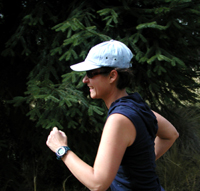Self Efficacy, Physical Activity, and its Relation to Depression and Fatigue

Research has shown that physical activity (PA) has been associated with a reduction in fatigue in some cancer survivors. A recent study shows that this relationship may also have to do with how a person thinks about physical activity, and not just the physical activity itself, which can affect a cancer survivor’s level of depression and fatigue.
This longitudinal nationwide study of 1,527 breast cancer survivors looked at the change in fatigue at baseline and 6 month follow-up based on changes in PA participation, participants’ belief in their ability to exercise regularly (self-efficacy), and both of those variables’ relation to depression. Study authors, supported by a grant from the National Institute on Aging, part of the National Institutes of Health, hypothesized that physical activity indirectly influences fatigue via effects on self-efficacy and depression.
Participants were asked a series of questions via self-reported questionnaires at baseline and 6 month follow-up to determine their levels of fatigue (severity, frequency, and daily variation), depressive state, frequency of physical activity, and self-efficacy. A smaller participant subgroup wore accelerometers to measure their actual physical activity levels during a short time period.
The authors also hypothesized relationships between the variables, such as a direct path from physical activity to exercise self-efficacy, a direct path from exercise self-efficacy to depression, a direct path from exercise self-efficacy to fatigue, and a direct path from depression to fatigue.
Results showed that at baseline, breast cancer (BC) survivors who participated in more physical activity had higher exercise self-efficacy, and in turn BC survivors with higher self-efficacy had significantly lower levels of fatigue and depression. Women who reported higher levels of depression reported higher levels of fatigue. Also, fatigue at baseline was significantly related to depression at 6 months.
At 6 month follow-up, BC survivors whose physical activity had increased also had significant increases in exercise self-efficacy, and in turn, women who reported increases in self-efficacy reported decreased levels of depression and fatigue. There were significant indirect paths between residual changes in PA and self-efficacy alone and both exercise self-efficacy and depression.
A few other interesting findings from this study showed that older women reported higher levels of exercise self-efficacy, and lower levels of fatigue and depression. As can be expected, the reporting of more comorbidities (e.g., arthritis, osteoporosis, asthma) was associated with lower physical activity and self-efficacy and higher levels of fatigue and depression. More advanced disease state was also related with lower levels of PA and exercise self-efficacy and higher levels of depression.
While this study dealt with self-reported data, it is an interesting look at the psychosocial pathways that relate to the relationship between physical activity and fatigue, along with their relation to self-efficacy and depression. The authors noted that “the influence of physical activity on fatigue was indirect rather than direct, operating through the psychosocial factors of exercise self-efficacy and depression.” Self-efficacy could be used as a modifiable outcome between PA and fatigue, with the proper targeting of information around increasing one’s self-efficacy related to PA. Examples could include providing information about low cost exercise options, connections between exercise and fatigue improvement, and providing survivors with short mild exercise goals, such as leisurely walking.
More information is available on this study through the PubMed: http://www.ncbi.nlm.nih.gov/pubmed/23456557
Phillips, S.M. & McAuley, E. (2013). Physical activity and fatigue in breast cancer survivors: A panel model examining the role of self-efficacy and depression.Cancer Epidemiology, Biomarkers &Prevention published online first March 1, 2013.





